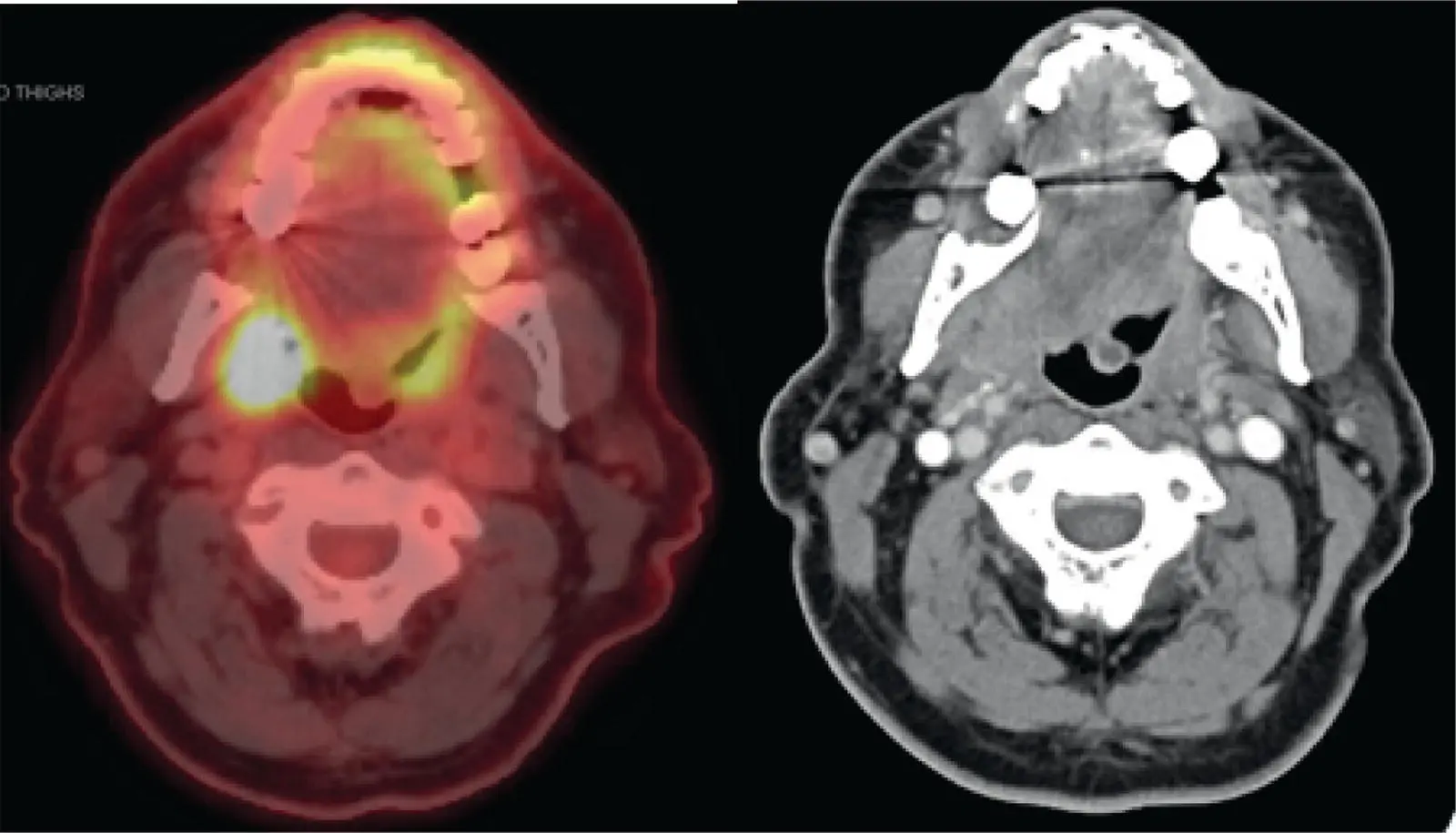Viruses are an etiologic factor in head and neck carcinoma, and testing for HPV and EBV can be performed on the FNA specimen to yield valuable additional information.
Patients with a single lymph node and without evidence of extranodal extension of disease may be successfully treated with a surgical approach involving complete resection of the primary and neck dissection if there is no perineural or lymphovascular invasion and if the primary site is small and has negative margins.
Lingual tonsillectomy and palatine tonsillectomy should be performed in cases of an unknown primary as the tonsils are often the site of unknown primary tumors.
Jason I. Kass and Glenn J. Hanna
History of Present Illness
A 55‐year‐old man presents with a 6‐month history of a persistent sore throat, which did not improve with antibiotics. He presented to his local otolaryngologist, who identified a right anterior tonsil mass. Biopsy of this mass showed nonkeratinizing, invasive, poorly differentiated SCC, which was p16 positive by immunostaining.
Question: What additional questions would you want to ask?
Any trouble opening his mouth? Yes. He reports right‐sided jaw pain that limits his mouth opening.
Any trouble swallowing? Patient denies., but he does have a globus sensation in his throat.
Any voice changes? Patient denies.
Any other lumps that have been noticed? Patient denies.
Any ear pain? Yes. He has pain in his right ear that radiates to his shoulder.
Has he received any treatment for this? Yes. He is taking acetaminophen‐oxycodone every 3 hours for relief.
Type II diabetes mellitus and hypertension.
Cholecystectomy 10 years ago.
50 pack‐year history of tobacco use.
A glass of wine with dinner on a regular basis.
Well‐developed middle‐aged male in no distress. Voice strong.
Skin: no suspicious lesions.
Oral cavity: limited mouth opening to 2.5 cm. Teeth in good condition. No lesions seen or palpated.
Oropharynx exam: 2.5 cm mass in the right anterior tonsillar pillar extending to the retromolar trigone. The mass is firm and fixed.
Neck exam: salivary gland exam is normal and there is no adenopathy.
Cranial nerves II–XII intact.
Flexible laryngoscopy: right oropharynx mass producing some displacement of the right palate superiorly, but no other lesions noted in any level of the pharynx or larynx. The true vocal folds move well.
Question: Which of the following imaging studies would be appropriate next steps in the evaluation and management of this patient?
A CT of the neck and chest with IV contrast: yes/no. This is a potential next step as this will allow for evaluation of the neck and the upper aerodigestive tract. CT chest will complete the metastatic workup. CT images are rapidly obtained and provide both soft tissue and bone detail. For patients being considered for transoral robotic resection, it is important to evaluate for a retropharyngeal carotid artery.
Neck ultrasound: yes/no. Neck ultrasound may be helpful here to assess for pathologic cervical lymphadenopathy and to assist with FNA, if needed. Newer techniques have also been described using transcervical ultrasound to assess for primary tumors of the palatine and lingual tonsil tissue. If a CT of the neck is performed, neck ultrasound would likely provide little additional benefit.
MRI of the neck: yes/no. This is a potential next step as this will allow for evaluation of the neck and the upper aerodigestive tract. MRI is particularly helpful in assessing for soft tissue extension to the base of tongue and/or the parapharyngeal space.
PET/CT neck: yes/no. This is a potential next step as this will allow for evaluation of the neck and the upper aerodigestive tract as well as provide assessment for metastatic disease. This study should typically be performed after confirming the presence of a malignancy.
A neck CT with IV contrast and PET/CT are both performed that show a 2.5 × 1.5 cm PET avid mass in the right tonsil with involvement of the right medial pterygoid muscle (see Figure 8.1). There is no suspicious cervical lymphadenopathy or evidence of distant disease.
Question: What is the clinical stage of this patient?
Answer:cT4N0M0. The involvement of the pterygoid musculature seen on the CT and his evolving trismus make this clinically a T4 tumor using the AJCC 8th Edition staging for HPV+ oropharyngeal tumors.
Question: What would be the most appropriate treatment option for this patient?
Answer:This is not a primary tumor best approached using transoral robotic surgery (TORS) for two reasons: (i) With the advanced nature of this tumor, and extension to the pterygoid musculature, obtaining a clean resection with negative margins is very challenging unless an open approach is used: (ii) this disease likely extends beyond the superior constrictor muscle, as evidenced by the effacement of the parapharyngeal fat plane. Negative surgical margins are important to consider in this setting because postoperative adjuvant therapy for positive resection margins warrants consideration of concurrent chemoradiotherapy – which commits the patient to a trimodality approach for therapy. While a traditional mandibular split approach will allow complete access to the tumor, this approach has its own morbidity, and due to the extent of the disease, postoperative radiation therapy is still required.
Question: What is the first line treatment plan for nonoperative disease in this scenario?
Answer:Radiotherapy with concurrent bolus cisplatin (dose: 100 mg/m 2IV every 21 days for three cycles). For locoregionally advanced cancers of the oropharynx treated nonoperatively, concurrent chemoradiotherapy remains the standard of care. Cisplatin is a potent radiosensitizer. The MACH‐NC meta‐analysis clarified the survival benefit of a combined chemoradiation approach with greater benefit for platinum‐containing chemotherapies.
The bolus schedule (every 3 weeks at higher dosing), however, more than doubles the risk of severe toxicities including mucositis, fibrosis, nausea and vomiting. It has been shown that increased toxicity occurs when cumulative dosing reaches 200–300 mg/m 2. To limit the toxicities of cisplatin, a weekly schedule has been adopted by many. Prospective data by Noronha et al. (2018) comparing weekly and bolus schedules demonstrated that a weekly schedule (30 mg/m 2, as opposed to 40 mg/m 2) was inferior in terms of locoregional control. Many institutions in the United States and Europe use 40 mg/m 2weekly, and retrospective data support similar response rates to bolus dosing with fewer toxicities. This is still an active area of study as there are no prospective studies comparing a bolus schedule to 40 mg/m 2weekly dosing.

FIGURE 8.1 These axial images of the fused PET/CT (left) and CT of the neck with IV contrast (right) demonstrate a right‐sided tonsillar mass with involvement of the right medial pterygoid muscle.
While radiotherapy with concurrent cetuximab was previously considered an appropriate alternative to cisplatin among platinum‐ineligible patients, RTOG 1016 and the European De‐ESCALaTE HPV studies both demonstrated the superiority of cisplatin in low‐risk, locoregionally advanced HPV+ oropharyngeal cancer patients, with improved overall survival and locoregional control rates with platinum compared to EGFR inhibitor therapy.
Читать дальше













